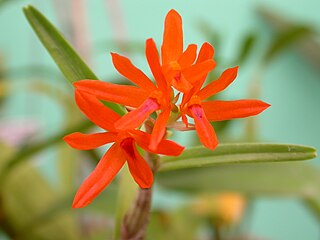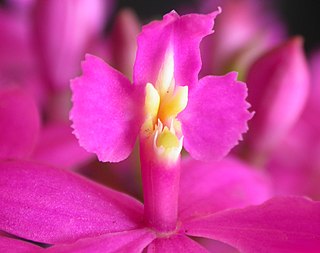
Stelis, or leach orchids, is a large genus of orchids, with perhaps 500 species. The generic name Stelis is the Greek word for 'mistletoe', referring to the epiphytic habit of these species. These mainly epiphytic plants are widely distributed throughout much of South America, Central America, Mexico, the West Indies and Florida.
The taxonomy of the Orchidaceae has evolved slowly during the last 250 years, starting with Carl Linnaeus who in 1753 recognized eight genera. De Jussieu recognized the Orchidaceae as a separate family in his Genera Plantarum in 1789. Olof Swartz recognized 25 genera in 1800. Louis Claude Richard provided us in 1817 with the descriptive terminology of the orchids.. The next step was taken in 1830-1840 by John Lindley, who recognized four subfamilies. He is generally recognized as the father of orchid taxonomy. The next important step was taken by George Bentham with a new classification, recognizing subtribes for the first time. This classification was first presented in a paper that Bentham read to the Royal Society in 1881. Then it was published in 1883 in the final volume of Genera Plantarum. The next great contributors were Pfitzer (1887), Schlechter (1926), Mansfeld (1937), Dressler and Dodson (1960), Garay, Vermeulen (1966), again Dressler (1981). and Burns-Balogh and Funk (1986). Dressler's 1993 book had considerable influence on later work.

Epidendrum, abbreviated Epi in the horticultural trade, is a large neotropical genus of the orchid family. With more than 1,500 species, some authors describe it as a mega-genus. The genus name refers to its epiphytic growth habit.

Prosthechea is a genus of flowering plants in the orchid family (Orchidaceae). The name is derived from the Greek word prostheke (appendix), referring to the appendage on the back of the column. Appendage orchid is a common name for this genus.

Laeliinae is a Neotropical subtribe including 40 orchid genera, such as Brassavola, Laelia and Cattleya. The genus Epidendrum is the largest within this subtribe, containing about 1500 species. This is followed by the genus Encyclia, with over 120 species.

Zeuxine, commonly known as verdant jewel orchids, is a genus of about eighty species of orchids in the tribe Cranichideae. They are native to parts of tropical Africa, Asia, Southeast Asia, New Guinea, Australia and some Pacific Islands. They have relatively narrow, dark green leaves and small, dull-coloured resupinate flowers with the dorsal sepal and petals overlapping to form a hood over the column. The labellum has a pouched base and its tip has two lobes.

Tolumnia, is a genus in the family Orchidaceae. Previously known as the "equitant Oncidiums", the species were segregated from the mega-genus Oncidium by Guido Braem in 1986. The plants are small, usually epiphytic, with small or absent pseudobulbs completely covered by leaves, which are triangular or circular in cross section and overlap each other at base to resemble a fan. The inflorescences arise between the leaf base and bear colorful, showy flowers. The labella are large, ornamented by variously shaped calli. The column bears prominent wings flanking the stigma. Dancing-lady orchid is a common name for some species in this genus.

Cylindrolobus is a genus of orchids with about 80 species that grow in New Guinea, Wallacea, Southeast Asia, southern China, and India.

Epidendrum flexuosum, a reed-stemmed Epidendrum common at mid-altitudes in Central America, is a species of orchid commonly called Epidendrum imatophyllum. It grows exposed to intense sunlight in the forest canopy, particularly on Guava species. E. flexuosum bears non-resupinate lavender flowers on a congested raceme at the end of a long peduncle.

Scaphyglottis is a genus of orchids native to Mexico, Central America, northern South America and parts of the Caribbean. The current concept of this genus is the result of combining several genera which have been described at various times. The concept is characterized by the growth habit: not only are new pseudobulbs added at the base of the old ones, but new pseudobulbs also grow at the apices of the old ones. Many species are quite similar and difficult to distinguish, but some are clearly distinct. A few have showy colors. The genus comprises nearly 70 species.

Pholidota, commonly known as rattlesnake orchids, is a genus of flowering plants from the orchid family, Orchidaceae. Plants in this genus are clump-forming epiphytes or lithophytes with pseudobulbs, each with a single large leaf and a large number of small, whitish flowers arranged in two ranks along a thin, wiry flowering stem that emerges from the top of the pseudobulb. There are about thirty five species native to areas from tropical and subtropical Asia to the southwestern Pacific.
The subgenus Hormidium of the genus Epidendrum of family Orchidaceae features short pseudobulbs, a creeping growth habit, a very short peduncle, and a lip adnate to the column to its apex. The subgenus was published by Lindley in 1841.

Epidendrum sect. SchistochilaRchb.f. (1861) is a section of the subgenus E. subg. AmphiglottiumLindl. (1841) of the Genus Epidendrum of the Orchidaceae. E. sect. Schistochila differs from the section E. sect. Holochila in that the species in E. sect. Holochila have undivided lips; the species in E. sect. Schistochila have lobate lips. The species in both E. sect. Schistochila and E. sect. Holochila have racemose inflorescences, unlike those in E. sect. Polycladia, which have truly paniculate inflorescences. Like the other sections of E. subg. Amphiglottium, the members of E. sect. Schistochila are sympodial orchids bearing thin stems with alternate leaves, a long peduncle covered with thin, imbricating sheathes, and a lip adnate to the very end of the column.

Epidendrum sect. PolycladiaRchb.f. 1861 is a section of the Subgenus E. subg. AmphiglottiumLindl. of the Genus Epidendrum of the Orchidaceae. This plants in this section differ from the plants in the other sections of E. subg. Amphiglottium by having truly paniculate inflorescences: the section E. sect. Holochila is characterized by racemose inflorescences and an undivided lip, and the section E. sect. Schistochila is characterized by racemose inflorescences and a lobed lip.
Epidendrum hemiscleria is a sympodial epiphytic orchid native to the tropical cloud forest of Ecuador and Peru, at altitudes near 3.3 km.

Epidendrum sophronitisLinden & Rchb.f. (1857) is a small Epidendrum orchid that bears a superficial resemblance to a Sophronitis, as the generic epithet was used prior to the year 2000.
Epidendrum subgenus Aulizeum was raised from sectional status by Lindley in 1853. According to the Latin diagnosis, this taxon included those species of Epidendrum with a multi-lobate lip adnate to the column, with pseudobulbous stems, with the flowers sessile or born on racemes or panicles. In his further English description, Lindley stated that the species in this taxon have a horn-like stem which is only leafy at the end, and racemose inflorescences. In 1861, Reichenbach listed 32 species in this subgenus; of these, Kew recognizes 31 as separate species.
Hormidium is a group of orchids whose various species have been transferred to Encyclia, Epidendrum, Homalopetalum, Lepanthes, and Prosthechea.













